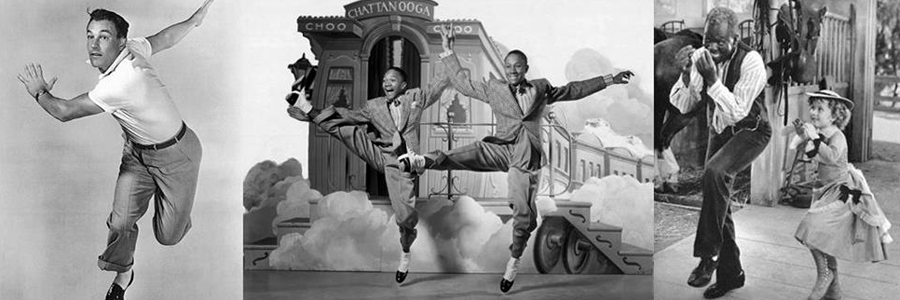
A Brief History of Tap
The early slave trade in America resulted in a rhythmic collision of
cultures. Slave-holders already fearful of revolt, began to panic
when it was discovered that Africans could communicate with each other
- over long distances and in code - through the use of drums. All
over the South, slave-holders forbid the use of drums and other native
instruments in African religious ceremonies. However, African-Americans
held on to their traditional rhythms by transferring them to their
feet. The tapping out of complex rhythmic passages was developed,
and a subtle, intricate and vital physical code of expression was born.
By the mid-nineteenth century, African-Americans had combined their
footwork with Irish and British clogging steps to create a style called
'Buck and Wing' which became Modern Tap Dance. The 'Buck and
Wing' was a mixture of jigs and reels and took as its basis the Buck
dance with one new addition, the 3 point wing. Buck dancing was a
flat footed type of dancing that was characterized by great strength
and vigor, it was mostly performed by males at the time and thus named
after the male of most animal species, the buck. King Rastus Brown was
the king of buck dancing as he used flat-footed shuffles and steps to
develop countless Time Steps and seemingly miraculous Breaks.
The mid-nineteenth century also saw the birth of the minstrel shows where white performers would black their faces and imitate Southern black performers and satirize their dance forms, in later minstrel shows black performers in blackface would play roles in which they imitated the Irish imitation of black dance forms further mixing the two. With the decline in popularity of the minstrel shows tap dancing moved towards the Vaudeville stage.
Bill 'Bojangles' Robinson
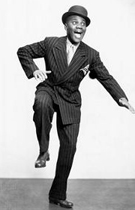
'Bill 'Bojangles' Robinson' pictured above, imerged in 1902, well versed in 'buck and wing' dancing and Irish step dancing 'Robinson' first entered the Vaudeville circuit as a duo due to the two colour rule, which forbade blacks from performing solo. 'Robinson' and his partner 'George W Cooper' quickly became famous headlining events across the country and touring England as well. The two later parted and 'Robinson' decided to form a solo act which was extremely rare for a black man at that time but despite this he went on to be a world famous celebrity having many leading roles in films, most memorable with 'Shirley Temple' tap dancing together on the stairs in the 1935 film 'The Little Colonel'.'Robinson' made a huge contribution to the development of tap as he merged meticulous technique with a vivacious and comic performance personality, he also took the structure of 'buck and wing' dancing - six one-bar Time Steps and a two-bar-break and brought the steps from the flat foot to his own method of dancing up on the ball of the feet. When 'Robinson' danced on the balls of his feet, the sounds produced were crisper and clearer than any tapper's before him. There was a similarity to clogging in his upright style and method of making sound, but with the added rhythmic characteristic of swing. It is this style of tap that students around the world continue to learn when they are taught traditional Time Steps. 'Robinson' was honoured on the 25th May 1989 for his contribution to tap dance when Congress institued a National Tap Dance Day on the 111th anniversary of his birth.
Between 1900 and the 1950's, tap's Golden era, many innovative tap dancers immerged creating their own styles by using complex rhythms and other dance influencs,some by stealing steps and adding their own creative expression to them.
John Bubbles
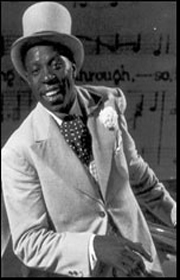
John Bubbles pictured above is credited with originating a new type of tap called 'rhythm tap' by creating complex, swinging rhythms with syncopated accents made by dropping heels and clicking toes. He did not use regular repititions like 'Robinson' and sometimes extended his phrases beyond eight bars. During a tap festival 'By Word of Foot' he half jokingly said that he improvised rather than repeating set steps so that no one could steal his dances.
Honi Coles & Cholly Atkins
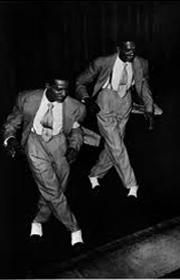
Honi Coles further developed the idea of extending the phrase beyond eight bars. He concentrated on fast, subtle footwork below a beautifully turning and traveling body. In contrast to the speed he is well know for his soft shoe, the slowest dance ever choreographed and performed about 1946 with his partner, Cholly Atkins. Both seen pictured above.
Steve & Frank Condos
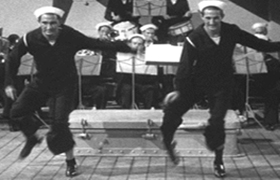
Frank Condos created the Condos concept of percussive dance and a firm believer in a foundation of practice and drills. His younger brother 'Steve Condos', influenced by his older brother, developed a stimulating and systematic technique that he called 'rudiments'. As a drummer does with his sticks, Steve produced innumerable mathematical variations on how many strikes each foot can do in a row, and in what order, he would then double each strike creating a new combination. Steve would practice the combinations at lightening speed getting as fast as a drummer does with a drum roll. Steve created a totally different feeling of expression and rhythm, with each new exciting variation and then moving the accent or putting in a pause, many of his ideas he created by improvising in front of a video camera and then when creating something new would play it back, practice it and create something else from it. The picture above shows the'Condos Brothers' performing together.
Hoofer's
All the above named were proud to be called 'Hoofers' as they focused primarily on rhythm and syncopated music of their feet. The term 'Hoofers' is derived from the 1920's and 'The Hoofer's Club' in Harlem, New York City. The owner Lonnie Hicks liked tap dancing and had some extra space in the club and let well known dancers and novices practice 24/7. Many great tap dancers started as novices at 'The Hoofer's Club', among them, Leonard Reed creator of the famous 'Shim Sham Shimmy' dance, which swept through New York City and everyone danced it at the end of an evening.
Fred Astaire & Ginger Rogers
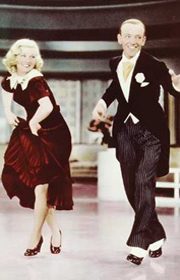
Fred Astaire, one of the most famous tap dancers brought a cool and debonaire style incorporating the full body movement of ballet and the grace and glamour of ballroom. Not to mention his partner who did everything Astaire did but in reverse and in high heels.
Eleanor Powell
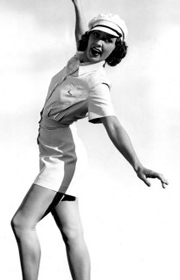
Eleanor Powell pictured above was another notable rhythmic tap dancer who combined intricate footwork with balletic whirling turns, dynamic movements and acrobatics. Her seven year movie career with MGM included many magnificent dance productions.
Gene Kelly, another of the most famous tap dancers of tap's Golden age, Kelly was handsome, of masculine build and danced with fast dynamic strength bringing romance and tap dance to his many film roles. He is probably most famous for his tap routine in 'Singin in the Rain', which he performed to perfection whilst suffering with the flu and a temperature of 102.
The 1950's saw the decline of Big Bands and the introduction of recorded music and disc jockeys, dominated by record companies it was get up and dance time but not get up and tap time. The TV also pushed people to stay at home rather than visit live stage shows. Tap was still seen on Broadway, however after Jerome Robbins choreographed and directed 'West Side Story' in 1957, tap shoes became silent as the image and composition of the musical, whether it was from Broadway or Hollywood, had changed form and concept so that contemporary dances first presented by de Mille in 'Oklahoma!' were firmly established. Rock and Roll and pop music had emerged along with jazz dance in its own right. Jazz dance evolved from tap dance so both styles have many moves in common.
The 1970's saw a revival in tap with an old 1925 Broadway musical 'No, No Nanette' starring Ruby Keeler age 62. It was the break that those who owned tap shoes had waited for. Tap also found its way onto university and college campuses and performing arts schools were created.
Bob Fosse, a song and dance man who began in the vaudeville era started to introduce some elements of tap into his productions, the 1972 film 'Cabaret' and the 1978 production of 'Dancin'. Gower Champion, a choreographer/director was directly responsible for reintroducing tap back on to the Broadway stage with the show '42nd Street'. Choreographer Michael Bennett also brought tap back into focus for a younger audience with the production of 'A Chorus Line' in 1975. The 1970's was a very productive decade for tap.
Gregory Hines
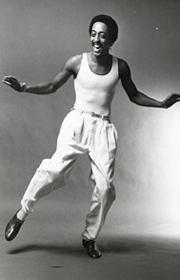
Gregory Hines (above) bridged the gap between the old 'Hoofers' and the younger talented tap dancers. Born in 1946 and died in 2003 aged 57, Hines was an actor, singer, dancer and choreographer who appeared in numerous tap dance productions, in 1998 he was awarded the Flo-Bert Awards Lifetime Achievement in Tap Dance by the New York Committee To Celebrate National Tap Dance Day.
Tap Dogs
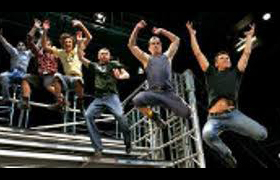
There have been many many more great contributors to the art of tap dance and rhythmic self expression, all who have kept the art alive and progressing through the years right up to today. Shows such as Tap Dogs' (above) and 'Stomp' are living proof of the progression in tap showing the dancers tapping on unusual materials such as metal using water and using other everyday items such as brooms and tin pots all to make different rhythmically interesting sounds.
'Riverdance' a brilliant production highlighting the difference in cultures of the Irish and American tappers in the battle scene which is spectacularly showing how two cultures come together in the end. The modern day musical 'Billy Elliot' shows how the love of dancing and tap dancing can give you strength when all the odds are against you. The tap dancing penguins in the animated film 'Happy Feet' has further reinforced the popular appeal of tap dancing....
